Poverty as a Driver of HIV/AIDS: A Case Study of Sub-Saharan Africa
VerifiedAdded on 2023/06/05
|10
|2814
|379
Essay
AI Summary
This essay examines the correlation between HIV/AIDS and poverty, with a specific focus on Sub-Saharan Africa. It highlights how poverty exacerbates conditions leading to higher HIV infection rates, such as commercial sex, forced marriages, and migration. The paper also discusses the United Nations' Sustainable Development Goals (SDGs) as a long-term solution, emphasizing goals related to health, education, gender equality, and reduced inequalities. The essay concludes that achieving these goals is crucial in reducing HIV infection rates and improving the overall well-being of affected populations, advocating for unity and focused efforts to combat the epidemic.
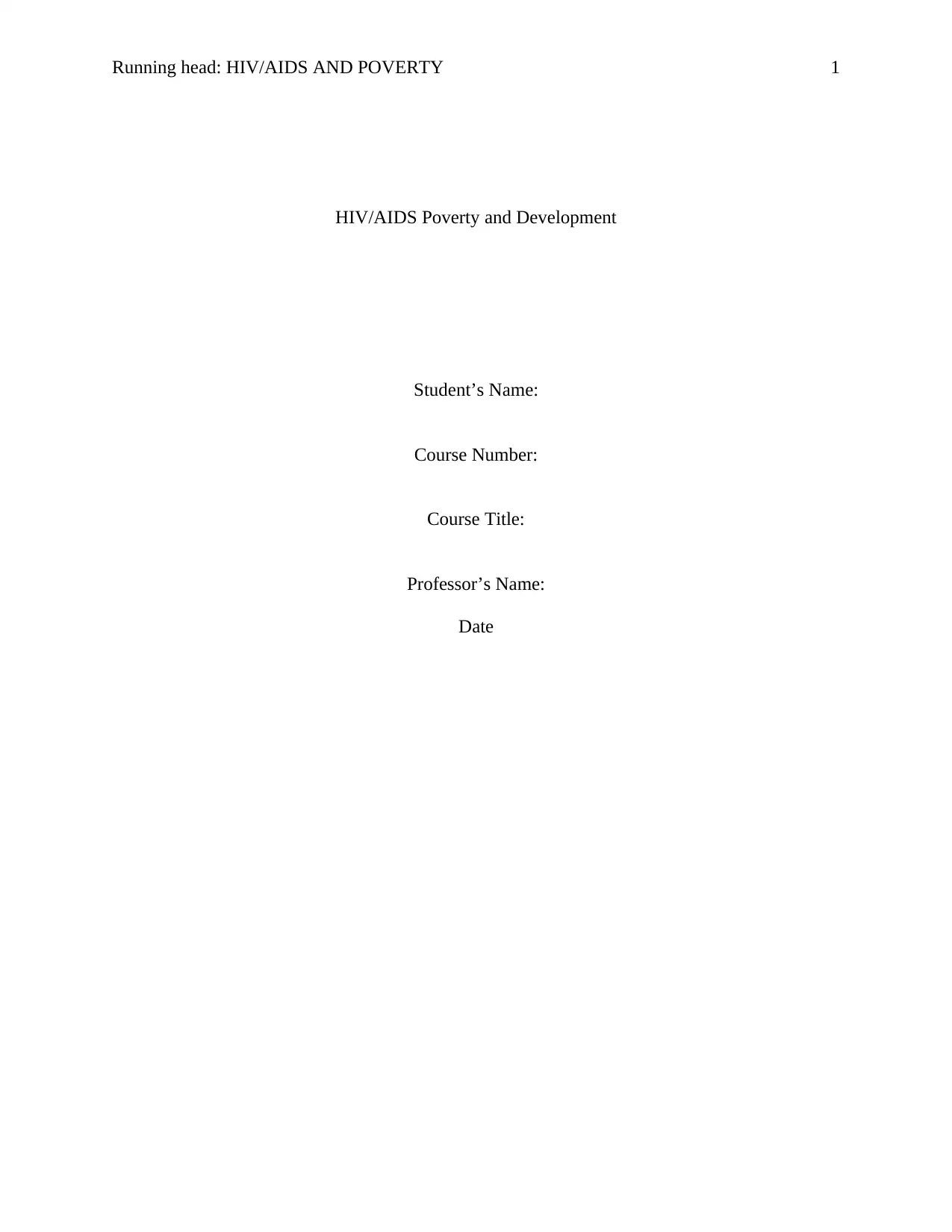
Running head: HIV/AIDS AND POVERTY 1
HIV/AIDS Poverty and Development
Student’s Name:
Course Number:
Course Title:
Professor’s Name:
Date
HIV/AIDS Poverty and Development
Student’s Name:
Course Number:
Course Title:
Professor’s Name:
Date
Paraphrase This Document
Need a fresh take? Get an instant paraphrase of this document with our AI Paraphraser
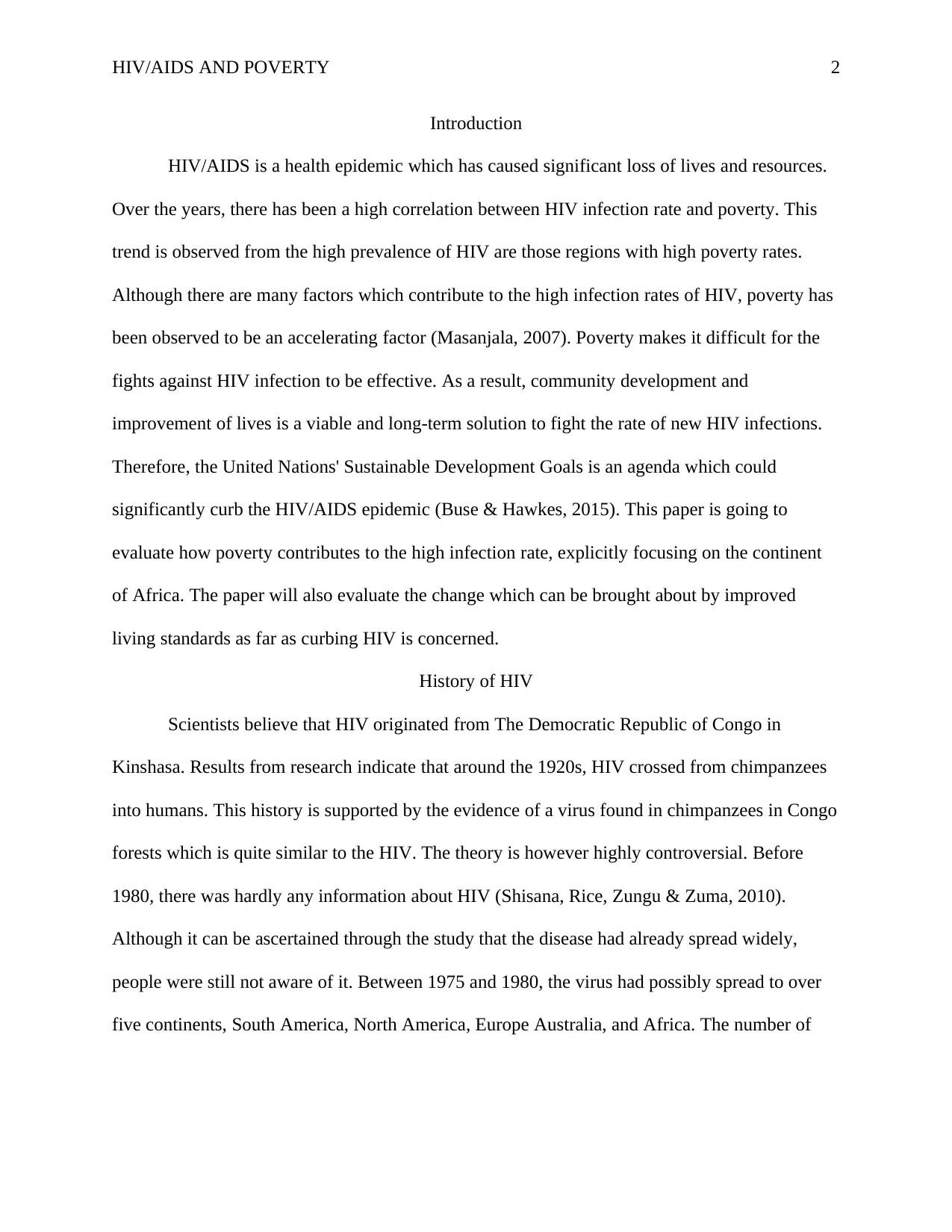
HIV/AIDS AND POVERTY 2
Introduction
HIV/AIDS is a health epidemic which has caused significant loss of lives and resources.
Over the years, there has been a high correlation between HIV infection rate and poverty. This
trend is observed from the high prevalence of HIV are those regions with high poverty rates.
Although there are many factors which contribute to the high infection rates of HIV, poverty has
been observed to be an accelerating factor (Masanjala, 2007). Poverty makes it difficult for the
fights against HIV infection to be effective. As a result, community development and
improvement of lives is a viable and long-term solution to fight the rate of new HIV infections.
Therefore, the United Nations' Sustainable Development Goals is an agenda which could
significantly curb the HIV/AIDS epidemic (Buse & Hawkes, 2015). This paper is going to
evaluate how poverty contributes to the high infection rate, explicitly focusing on the continent
of Africa. The paper will also evaluate the change which can be brought about by improved
living standards as far as curbing HIV is concerned.
History of HIV
Scientists believe that HIV originated from The Democratic Republic of Congo in
Kinshasa. Results from research indicate that around the 1920s, HIV crossed from chimpanzees
into humans. This history is supported by the evidence of a virus found in chimpanzees in Congo
forests which is quite similar to the HIV. The theory is however highly controversial. Before
1980, there was hardly any information about HIV (Shisana, Rice, Zungu & Zuma, 2010).
Although it can be ascertained through the study that the disease had already spread widely,
people were still not aware of it. Between 1975 and 1980, the virus had possibly spread to over
five continents, South America, North America, Europe Australia, and Africa. The number of
Introduction
HIV/AIDS is a health epidemic which has caused significant loss of lives and resources.
Over the years, there has been a high correlation between HIV infection rate and poverty. This
trend is observed from the high prevalence of HIV are those regions with high poverty rates.
Although there are many factors which contribute to the high infection rates of HIV, poverty has
been observed to be an accelerating factor (Masanjala, 2007). Poverty makes it difficult for the
fights against HIV infection to be effective. As a result, community development and
improvement of lives is a viable and long-term solution to fight the rate of new HIV infections.
Therefore, the United Nations' Sustainable Development Goals is an agenda which could
significantly curb the HIV/AIDS epidemic (Buse & Hawkes, 2015). This paper is going to
evaluate how poverty contributes to the high infection rate, explicitly focusing on the continent
of Africa. The paper will also evaluate the change which can be brought about by improved
living standards as far as curbing HIV is concerned.
History of HIV
Scientists believe that HIV originated from The Democratic Republic of Congo in
Kinshasa. Results from research indicate that around the 1920s, HIV crossed from chimpanzees
into humans. This history is supported by the evidence of a virus found in chimpanzees in Congo
forests which is quite similar to the HIV. The theory is however highly controversial. Before
1980, there was hardly any information about HIV (Shisana, Rice, Zungu & Zuma, 2010).
Although it can be ascertained through the study that the disease had already spread widely,
people were still not aware of it. Between 1975 and 1980, the virus had possibly spread to over
five continents, South America, North America, Europe Australia, and Africa. The number of
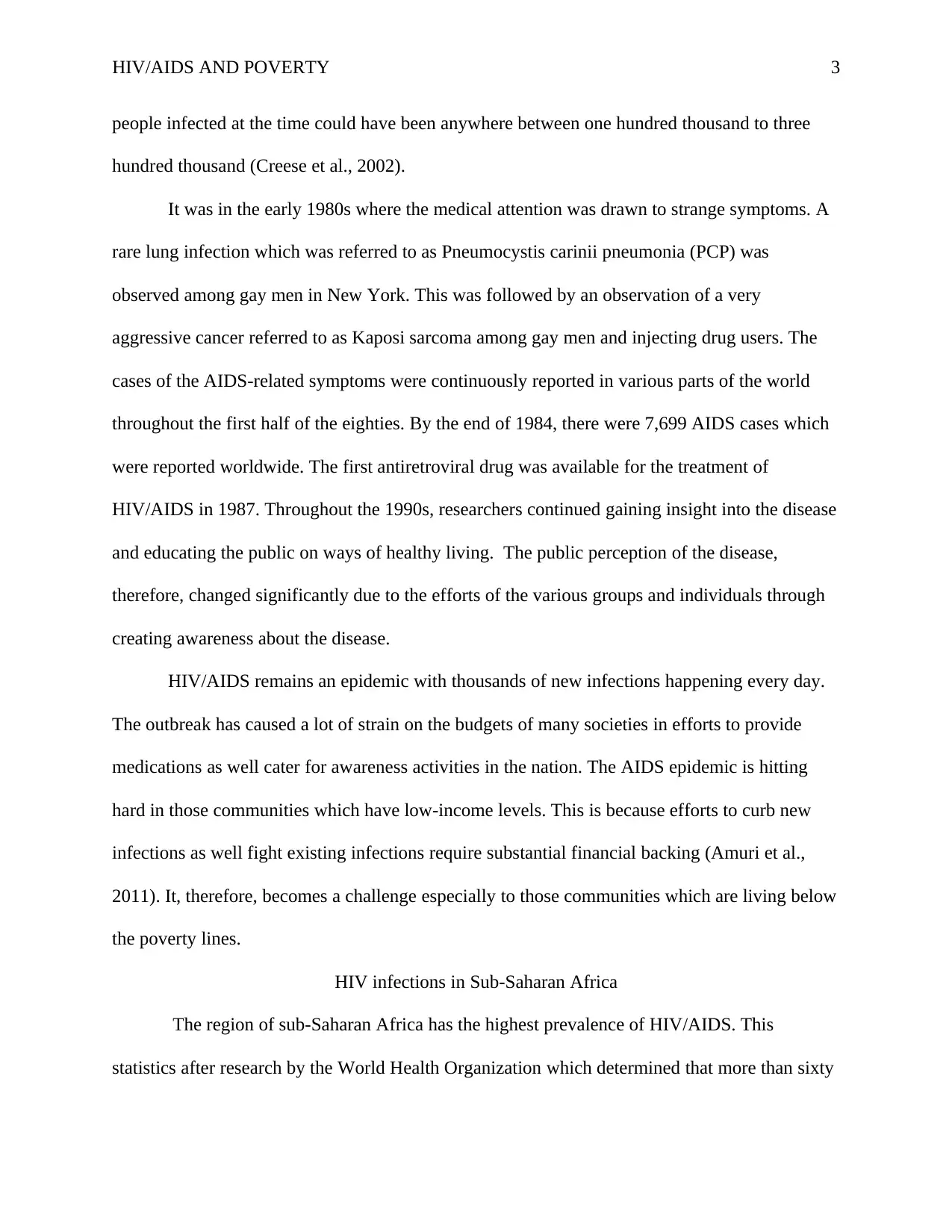
HIV/AIDS AND POVERTY 3
people infected at the time could have been anywhere between one hundred thousand to three
hundred thousand (Creese et al., 2002).
It was in the early 1980s where the medical attention was drawn to strange symptoms. A
rare lung infection which was referred to as Pneumocystis carinii pneumonia (PCP) was
observed among gay men in New York. This was followed by an observation of a very
aggressive cancer referred to as Kaposi sarcoma among gay men and injecting drug users. The
cases of the AIDS-related symptoms were continuously reported in various parts of the world
throughout the first half of the eighties. By the end of 1984, there were 7,699 AIDS cases which
were reported worldwide. The first antiretroviral drug was available for the treatment of
HIV/AIDS in 1987. Throughout the 1990s, researchers continued gaining insight into the disease
and educating the public on ways of healthy living. The public perception of the disease,
therefore, changed significantly due to the efforts of the various groups and individuals through
creating awareness about the disease.
HIV/AIDS remains an epidemic with thousands of new infections happening every day.
The outbreak has caused a lot of strain on the budgets of many societies in efforts to provide
medications as well cater for awareness activities in the nation. The AIDS epidemic is hitting
hard in those communities which have low-income levels. This is because efforts to curb new
infections as well fight existing infections require substantial financial backing (Amuri et al.,
2011). It, therefore, becomes a challenge especially to those communities which are living below
the poverty lines.
HIV infections in Sub-Saharan Africa
The region of sub-Saharan Africa has the highest prevalence of HIV/AIDS. This
statistics after research by the World Health Organization which determined that more than sixty
people infected at the time could have been anywhere between one hundred thousand to three
hundred thousand (Creese et al., 2002).
It was in the early 1980s where the medical attention was drawn to strange symptoms. A
rare lung infection which was referred to as Pneumocystis carinii pneumonia (PCP) was
observed among gay men in New York. This was followed by an observation of a very
aggressive cancer referred to as Kaposi sarcoma among gay men and injecting drug users. The
cases of the AIDS-related symptoms were continuously reported in various parts of the world
throughout the first half of the eighties. By the end of 1984, there were 7,699 AIDS cases which
were reported worldwide. The first antiretroviral drug was available for the treatment of
HIV/AIDS in 1987. Throughout the 1990s, researchers continued gaining insight into the disease
and educating the public on ways of healthy living. The public perception of the disease,
therefore, changed significantly due to the efforts of the various groups and individuals through
creating awareness about the disease.
HIV/AIDS remains an epidemic with thousands of new infections happening every day.
The outbreak has caused a lot of strain on the budgets of many societies in efforts to provide
medications as well cater for awareness activities in the nation. The AIDS epidemic is hitting
hard in those communities which have low-income levels. This is because efforts to curb new
infections as well fight existing infections require substantial financial backing (Amuri et al.,
2011). It, therefore, becomes a challenge especially to those communities which are living below
the poverty lines.
HIV infections in Sub-Saharan Africa
The region of sub-Saharan Africa has the highest prevalence of HIV/AIDS. This
statistics after research by the World Health Organization which determined that more than sixty
⊘ This is a preview!⊘
Do you want full access?
Subscribe today to unlock all pages.

Trusted by 1+ million students worldwide
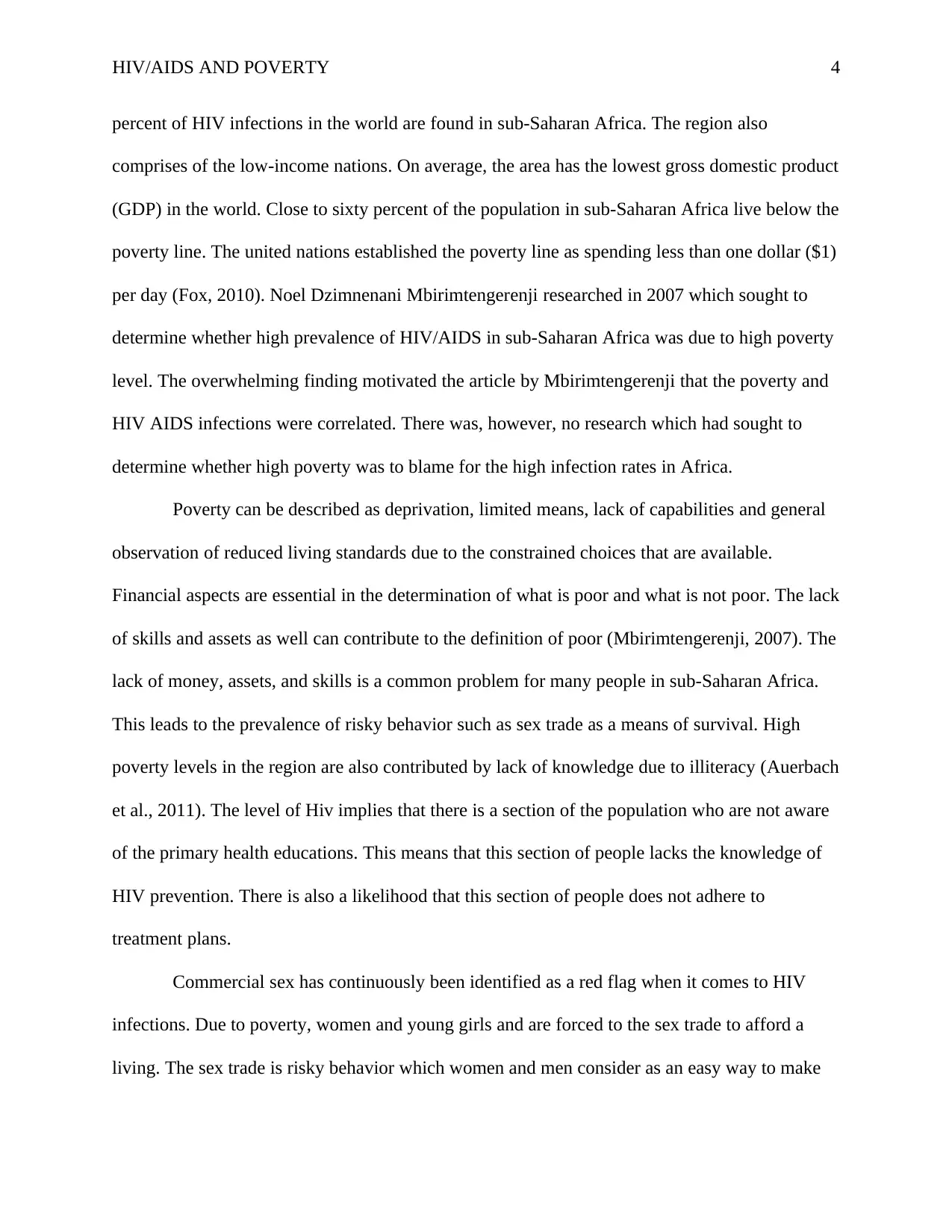
HIV/AIDS AND POVERTY 4
percent of HIV infections in the world are found in sub-Saharan Africa. The region also
comprises of the low-income nations. On average, the area has the lowest gross domestic product
(GDP) in the world. Close to sixty percent of the population in sub-Saharan Africa live below the
poverty line. The united nations established the poverty line as spending less than one dollar ($1)
per day (Fox, 2010). Noel Dzimnenani Mbirimtengerenji researched in 2007 which sought to
determine whether high prevalence of HIV/AIDS in sub-Saharan Africa was due to high poverty
level. The overwhelming finding motivated the article by Mbirimtengerenji that the poverty and
HIV AIDS infections were correlated. There was, however, no research which had sought to
determine whether high poverty was to blame for the high infection rates in Africa.
Poverty can be described as deprivation, limited means, lack of capabilities and general
observation of reduced living standards due to the constrained choices that are available.
Financial aspects are essential in the determination of what is poor and what is not poor. The lack
of skills and assets as well can contribute to the definition of poor (Mbirimtengerenji, 2007). The
lack of money, assets, and skills is a common problem for many people in sub-Saharan Africa.
This leads to the prevalence of risky behavior such as sex trade as a means of survival. High
poverty levels in the region are also contributed by lack of knowledge due to illiteracy (Auerbach
et al., 2011). The level of Hiv implies that there is a section of the population who are not aware
of the primary health educations. This means that this section of people lacks the knowledge of
HIV prevention. There is also a likelihood that this section of people does not adhere to
treatment plans.
Commercial sex has continuously been identified as a red flag when it comes to HIV
infections. Due to poverty, women and young girls and are forced to the sex trade to afford a
living. The sex trade is risky behavior which women and men consider as an easy way to make
percent of HIV infections in the world are found in sub-Saharan Africa. The region also
comprises of the low-income nations. On average, the area has the lowest gross domestic product
(GDP) in the world. Close to sixty percent of the population in sub-Saharan Africa live below the
poverty line. The united nations established the poverty line as spending less than one dollar ($1)
per day (Fox, 2010). Noel Dzimnenani Mbirimtengerenji researched in 2007 which sought to
determine whether high prevalence of HIV/AIDS in sub-Saharan Africa was due to high poverty
level. The overwhelming finding motivated the article by Mbirimtengerenji that the poverty and
HIV AIDS infections were correlated. There was, however, no research which had sought to
determine whether high poverty was to blame for the high infection rates in Africa.
Poverty can be described as deprivation, limited means, lack of capabilities and general
observation of reduced living standards due to the constrained choices that are available.
Financial aspects are essential in the determination of what is poor and what is not poor. The lack
of skills and assets as well can contribute to the definition of poor (Mbirimtengerenji, 2007). The
lack of money, assets, and skills is a common problem for many people in sub-Saharan Africa.
This leads to the prevalence of risky behavior such as sex trade as a means of survival. High
poverty levels in the region are also contributed by lack of knowledge due to illiteracy (Auerbach
et al., 2011). The level of Hiv implies that there is a section of the population who are not aware
of the primary health educations. This means that this section of people lacks the knowledge of
HIV prevention. There is also a likelihood that this section of people does not adhere to
treatment plans.
Commercial sex has continuously been identified as a red flag when it comes to HIV
infections. Due to poverty, women and young girls and are forced to the sex trade to afford a
living. The sex trade is risky behavior which women and men consider as an easy way to make
Paraphrase This Document
Need a fresh take? Get an instant paraphrase of this document with our AI Paraphraser
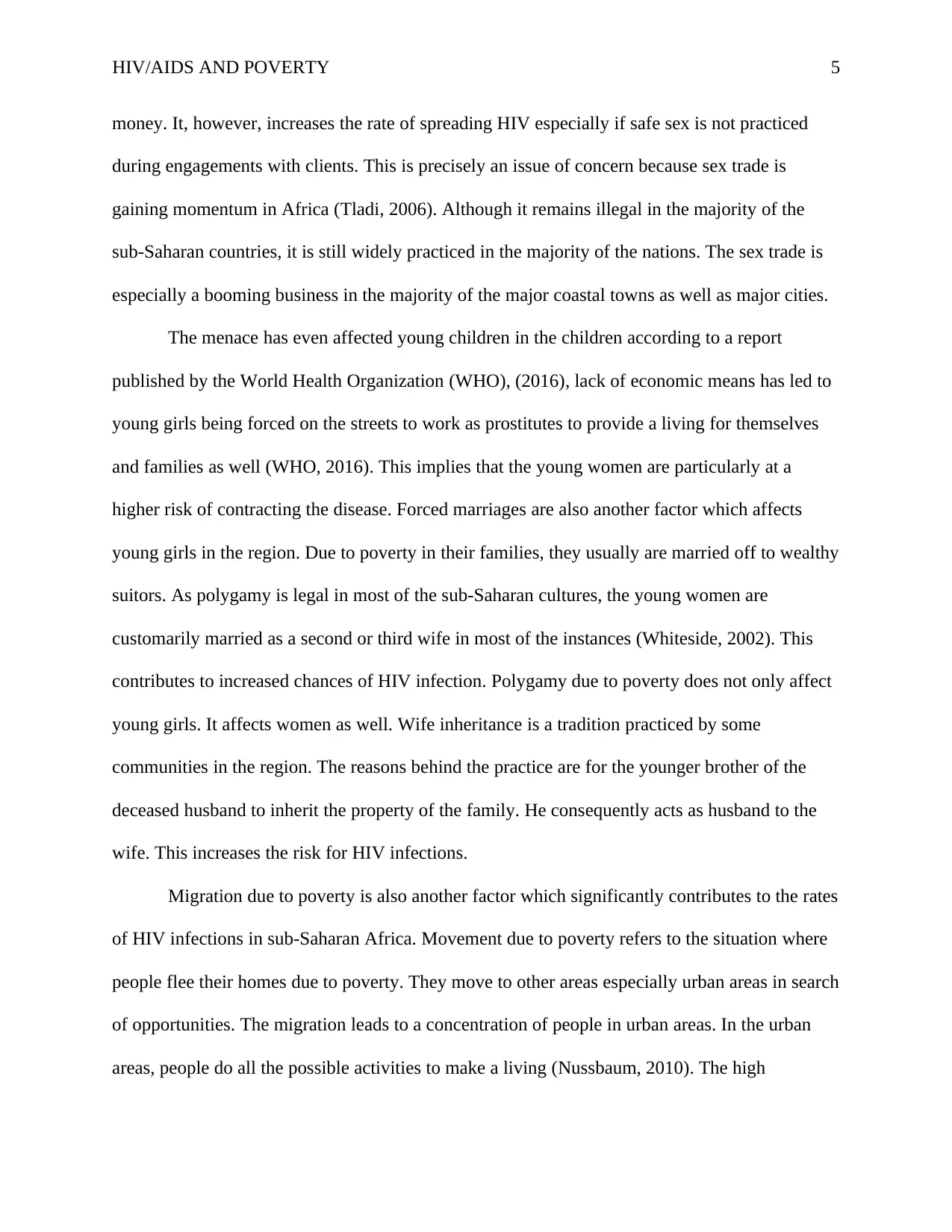
HIV/AIDS AND POVERTY 5
money. It, however, increases the rate of spreading HIV especially if safe sex is not practiced
during engagements with clients. This is precisely an issue of concern because sex trade is
gaining momentum in Africa (Tladi, 2006). Although it remains illegal in the majority of the
sub-Saharan countries, it is still widely practiced in the majority of the nations. The sex trade is
especially a booming business in the majority of the major coastal towns as well as major cities.
The menace has even affected young children in the children according to a report
published by the World Health Organization (WHO), (2016), lack of economic means has led to
young girls being forced on the streets to work as prostitutes to provide a living for themselves
and families as well (WHO, 2016). This implies that the young women are particularly at a
higher risk of contracting the disease. Forced marriages are also another factor which affects
young girls in the region. Due to poverty in their families, they usually are married off to wealthy
suitors. As polygamy is legal in most of the sub-Saharan cultures, the young women are
customarily married as a second or third wife in most of the instances (Whiteside, 2002). This
contributes to increased chances of HIV infection. Polygamy due to poverty does not only affect
young girls. It affects women as well. Wife inheritance is a tradition practiced by some
communities in the region. The reasons behind the practice are for the younger brother of the
deceased husband to inherit the property of the family. He consequently acts as husband to the
wife. This increases the risk for HIV infections.
Migration due to poverty is also another factor which significantly contributes to the rates
of HIV infections in sub-Saharan Africa. Movement due to poverty refers to the situation where
people flee their homes due to poverty. They move to other areas especially urban areas in search
of opportunities. The migration leads to a concentration of people in urban areas. In the urban
areas, people do all the possible activities to make a living (Nussbaum, 2010). The high
money. It, however, increases the rate of spreading HIV especially if safe sex is not practiced
during engagements with clients. This is precisely an issue of concern because sex trade is
gaining momentum in Africa (Tladi, 2006). Although it remains illegal in the majority of the
sub-Saharan countries, it is still widely practiced in the majority of the nations. The sex trade is
especially a booming business in the majority of the major coastal towns as well as major cities.
The menace has even affected young children in the children according to a report
published by the World Health Organization (WHO), (2016), lack of economic means has led to
young girls being forced on the streets to work as prostitutes to provide a living for themselves
and families as well (WHO, 2016). This implies that the young women are particularly at a
higher risk of contracting the disease. Forced marriages are also another factor which affects
young girls in the region. Due to poverty in their families, they usually are married off to wealthy
suitors. As polygamy is legal in most of the sub-Saharan cultures, the young women are
customarily married as a second or third wife in most of the instances (Whiteside, 2002). This
contributes to increased chances of HIV infection. Polygamy due to poverty does not only affect
young girls. It affects women as well. Wife inheritance is a tradition practiced by some
communities in the region. The reasons behind the practice are for the younger brother of the
deceased husband to inherit the property of the family. He consequently acts as husband to the
wife. This increases the risk for HIV infections.
Migration due to poverty is also another factor which significantly contributes to the rates
of HIV infections in sub-Saharan Africa. Movement due to poverty refers to the situation where
people flee their homes due to poverty. They move to other areas especially urban areas in search
of opportunities. The migration leads to a concentration of people in urban areas. In the urban
areas, people do all the possible activities to make a living (Nussbaum, 2010). The high
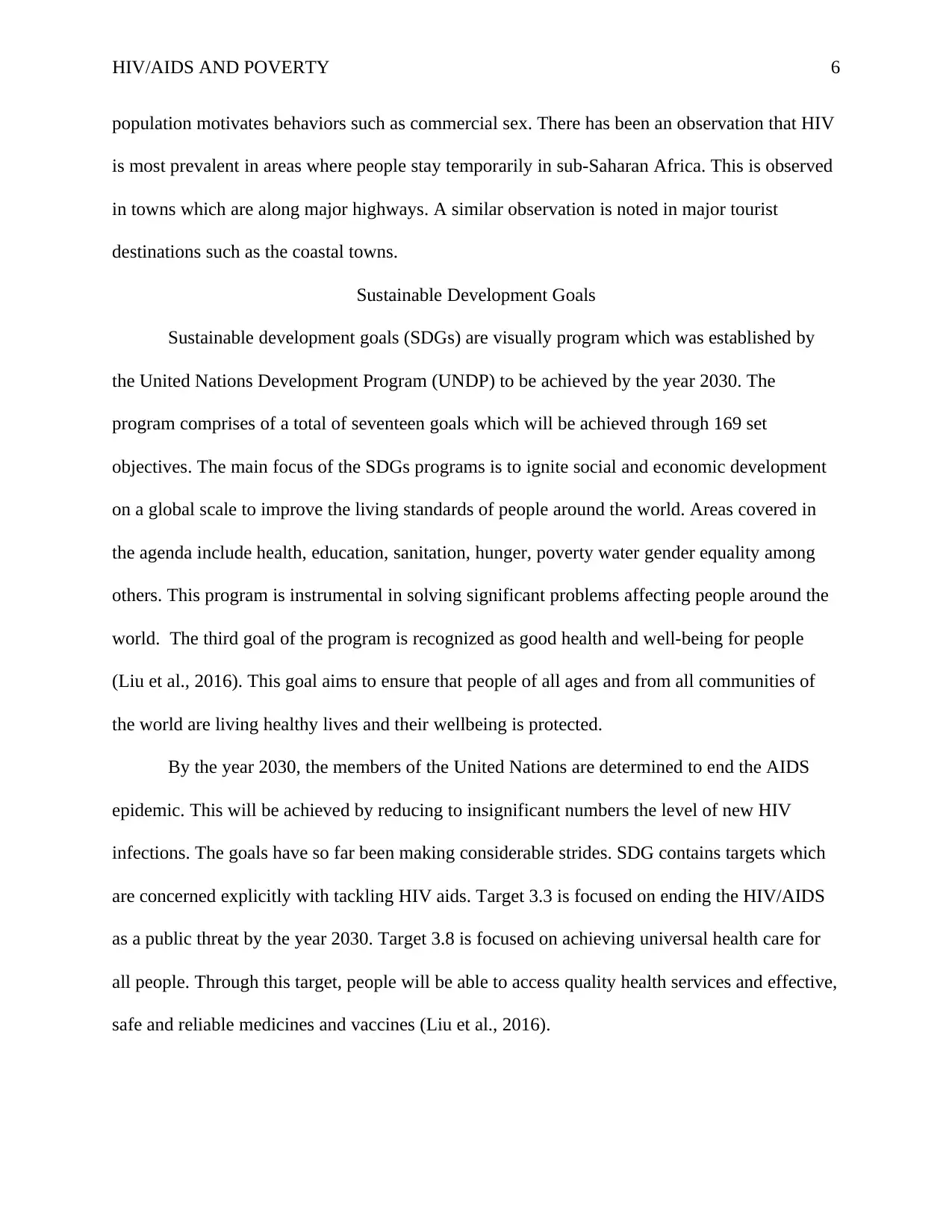
HIV/AIDS AND POVERTY 6
population motivates behaviors such as commercial sex. There has been an observation that HIV
is most prevalent in areas where people stay temporarily in sub-Saharan Africa. This is observed
in towns which are along major highways. A similar observation is noted in major tourist
destinations such as the coastal towns.
Sustainable Development Goals
Sustainable development goals (SDGs) are visually program which was established by
the United Nations Development Program (UNDP) to be achieved by the year 2030. The
program comprises of a total of seventeen goals which will be achieved through 169 set
objectives. The main focus of the SDGs programs is to ignite social and economic development
on a global scale to improve the living standards of people around the world. Areas covered in
the agenda include health, education, sanitation, hunger, poverty water gender equality among
others. This program is instrumental in solving significant problems affecting people around the
world. The third goal of the program is recognized as good health and well-being for people
(Liu et al., 2016). This goal aims to ensure that people of all ages and from all communities of
the world are living healthy lives and their wellbeing is protected.
By the year 2030, the members of the United Nations are determined to end the AIDS
epidemic. This will be achieved by reducing to insignificant numbers the level of new HIV
infections. The goals have so far been making considerable strides. SDG contains targets which
are concerned explicitly with tackling HIV aids. Target 3.3 is focused on ending the HIV/AIDS
as a public threat by the year 2030. Target 3.8 is focused on achieving universal health care for
all people. Through this target, people will be able to access quality health services and effective,
safe and reliable medicines and vaccines (Liu et al., 2016).
population motivates behaviors such as commercial sex. There has been an observation that HIV
is most prevalent in areas where people stay temporarily in sub-Saharan Africa. This is observed
in towns which are along major highways. A similar observation is noted in major tourist
destinations such as the coastal towns.
Sustainable Development Goals
Sustainable development goals (SDGs) are visually program which was established by
the United Nations Development Program (UNDP) to be achieved by the year 2030. The
program comprises of a total of seventeen goals which will be achieved through 169 set
objectives. The main focus of the SDGs programs is to ignite social and economic development
on a global scale to improve the living standards of people around the world. Areas covered in
the agenda include health, education, sanitation, hunger, poverty water gender equality among
others. This program is instrumental in solving significant problems affecting people around the
world. The third goal of the program is recognized as good health and well-being for people
(Liu et al., 2016). This goal aims to ensure that people of all ages and from all communities of
the world are living healthy lives and their wellbeing is protected.
By the year 2030, the members of the United Nations are determined to end the AIDS
epidemic. This will be achieved by reducing to insignificant numbers the level of new HIV
infections. The goals have so far been making considerable strides. SDG contains targets which
are concerned explicitly with tackling HIV aids. Target 3.3 is focused on ending the HIV/AIDS
as a public threat by the year 2030. Target 3.8 is focused on achieving universal health care for
all people. Through this target, people will be able to access quality health services and effective,
safe and reliable medicines and vaccines (Liu et al., 2016).
⊘ This is a preview!⊘
Do you want full access?
Subscribe today to unlock all pages.

Trusted by 1+ million students worldwide
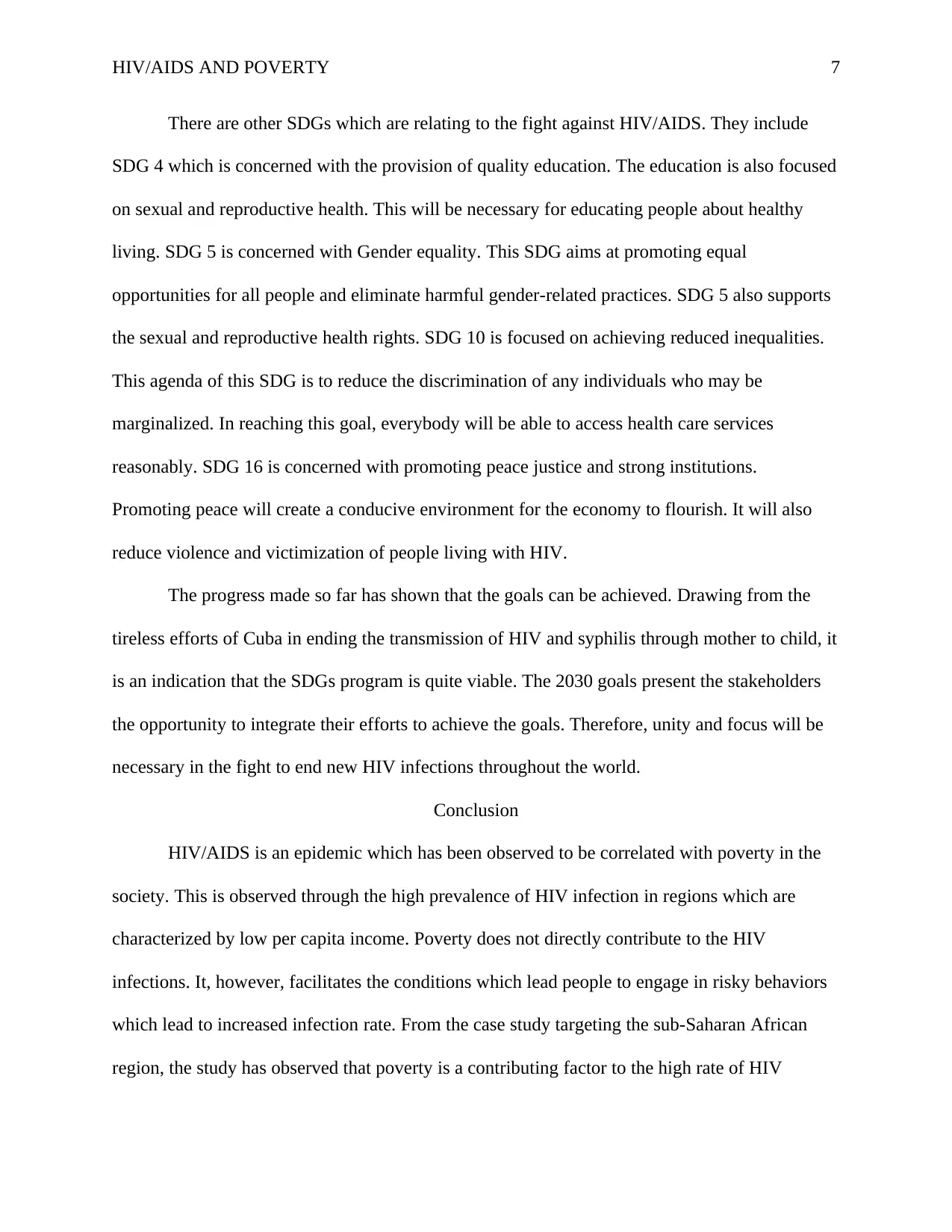
HIV/AIDS AND POVERTY 7
There are other SDGs which are relating to the fight against HIV/AIDS. They include
SDG 4 which is concerned with the provision of quality education. The education is also focused
on sexual and reproductive health. This will be necessary for educating people about healthy
living. SDG 5 is concerned with Gender equality. This SDG aims at promoting equal
opportunities for all people and eliminate harmful gender-related practices. SDG 5 also supports
the sexual and reproductive health rights. SDG 10 is focused on achieving reduced inequalities.
This agenda of this SDG is to reduce the discrimination of any individuals who may be
marginalized. In reaching this goal, everybody will be able to access health care services
reasonably. SDG 16 is concerned with promoting peace justice and strong institutions.
Promoting peace will create a conducive environment for the economy to flourish. It will also
reduce violence and victimization of people living with HIV.
The progress made so far has shown that the goals can be achieved. Drawing from the
tireless efforts of Cuba in ending the transmission of HIV and syphilis through mother to child, it
is an indication that the SDGs program is quite viable. The 2030 goals present the stakeholders
the opportunity to integrate their efforts to achieve the goals. Therefore, unity and focus will be
necessary in the fight to end new HIV infections throughout the world.
Conclusion
HIV/AIDS is an epidemic which has been observed to be correlated with poverty in the
society. This is observed through the high prevalence of HIV infection in regions which are
characterized by low per capita income. Poverty does not directly contribute to the HIV
infections. It, however, facilitates the conditions which lead people to engage in risky behaviors
which lead to increased infection rate. From the case study targeting the sub-Saharan African
region, the study has observed that poverty is a contributing factor to the high rate of HIV
There are other SDGs which are relating to the fight against HIV/AIDS. They include
SDG 4 which is concerned with the provision of quality education. The education is also focused
on sexual and reproductive health. This will be necessary for educating people about healthy
living. SDG 5 is concerned with Gender equality. This SDG aims at promoting equal
opportunities for all people and eliminate harmful gender-related practices. SDG 5 also supports
the sexual and reproductive health rights. SDG 10 is focused on achieving reduced inequalities.
This agenda of this SDG is to reduce the discrimination of any individuals who may be
marginalized. In reaching this goal, everybody will be able to access health care services
reasonably. SDG 16 is concerned with promoting peace justice and strong institutions.
Promoting peace will create a conducive environment for the economy to flourish. It will also
reduce violence and victimization of people living with HIV.
The progress made so far has shown that the goals can be achieved. Drawing from the
tireless efforts of Cuba in ending the transmission of HIV and syphilis through mother to child, it
is an indication that the SDGs program is quite viable. The 2030 goals present the stakeholders
the opportunity to integrate their efforts to achieve the goals. Therefore, unity and focus will be
necessary in the fight to end new HIV infections throughout the world.
Conclusion
HIV/AIDS is an epidemic which has been observed to be correlated with poverty in the
society. This is observed through the high prevalence of HIV infection in regions which are
characterized by low per capita income. Poverty does not directly contribute to the HIV
infections. It, however, facilitates the conditions which lead people to engage in risky behaviors
which lead to increased infection rate. From the case study targeting the sub-Saharan African
region, the study has observed that poverty is a contributing factor to the high rate of HIV
Paraphrase This Document
Need a fresh take? Get an instant paraphrase of this document with our AI Paraphraser
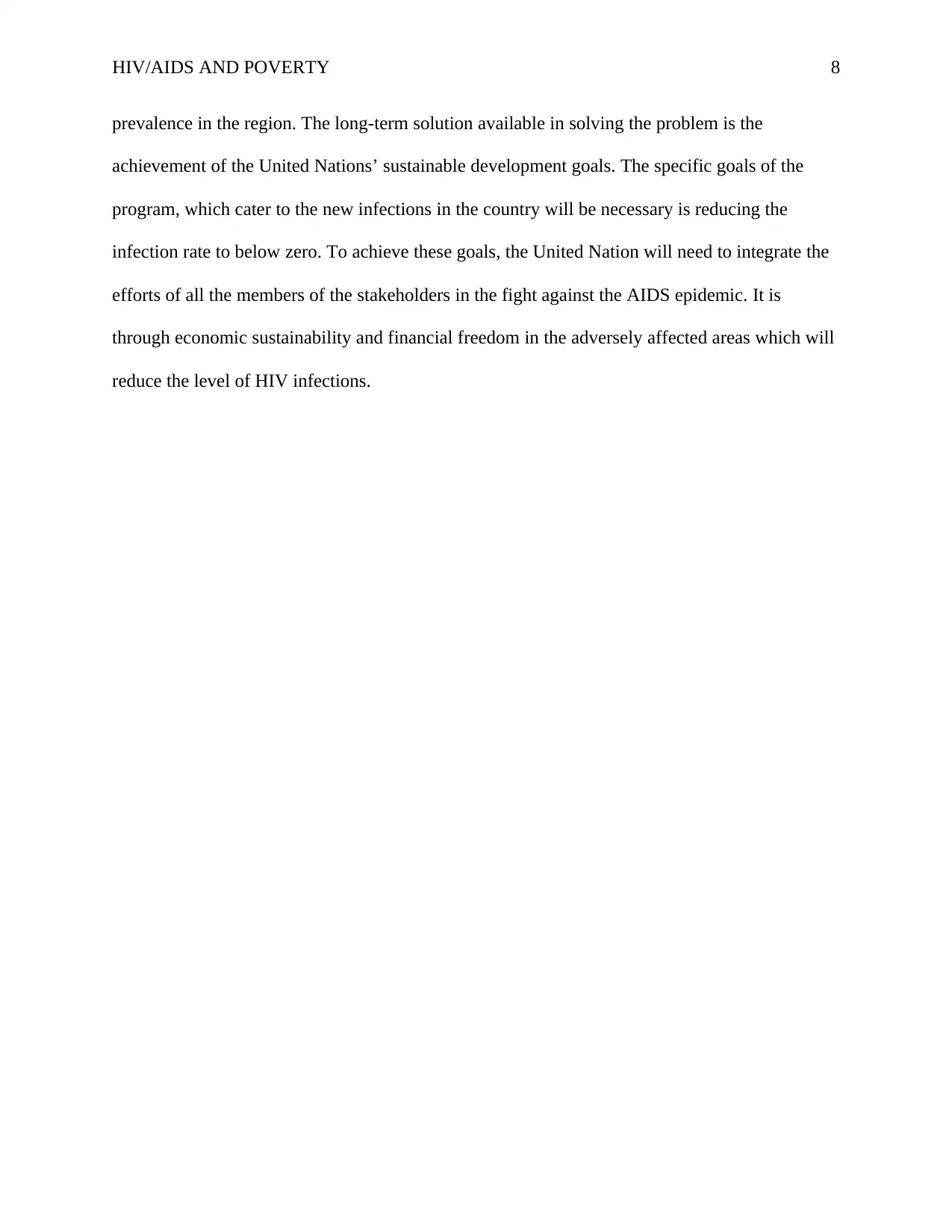
HIV/AIDS AND POVERTY 8
prevalence in the region. The long-term solution available in solving the problem is the
achievement of the United Nations’ sustainable development goals. The specific goals of the
program, which cater to the new infections in the country will be necessary is reducing the
infection rate to below zero. To achieve these goals, the United Nation will need to integrate the
efforts of all the members of the stakeholders in the fight against the AIDS epidemic. It is
through economic sustainability and financial freedom in the adversely affected areas which will
reduce the level of HIV infections.
prevalence in the region. The long-term solution available in solving the problem is the
achievement of the United Nations’ sustainable development goals. The specific goals of the
program, which cater to the new infections in the country will be necessary is reducing the
infection rate to below zero. To achieve these goals, the United Nation will need to integrate the
efforts of all the members of the stakeholders in the fight against the AIDS epidemic. It is
through economic sustainability and financial freedom in the adversely affected areas which will
reduce the level of HIV infections.
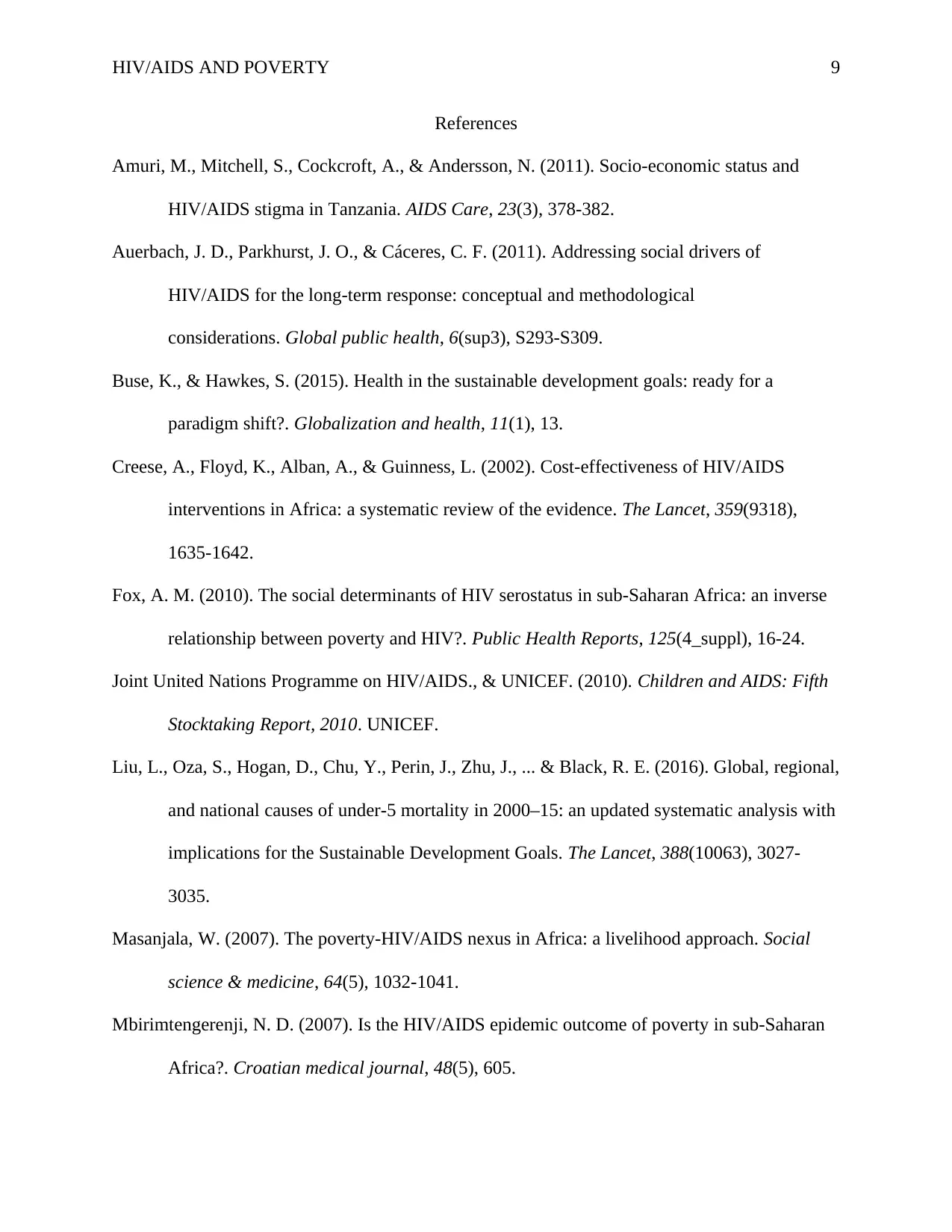
HIV/AIDS AND POVERTY 9
References
Amuri, M., Mitchell, S., Cockcroft, A., & Andersson, N. (2011). Socio-economic status and
HIV/AIDS stigma in Tanzania. AIDS Care, 23(3), 378-382.
Auerbach, J. D., Parkhurst, J. O., & Cáceres, C. F. (2011). Addressing social drivers of
HIV/AIDS for the long-term response: conceptual and methodological
considerations. Global public health, 6(sup3), S293-S309.
Buse, K., & Hawkes, S. (2015). Health in the sustainable development goals: ready for a
paradigm shift?. Globalization and health, 11(1), 13.
Creese, A., Floyd, K., Alban, A., & Guinness, L. (2002). Cost-effectiveness of HIV/AIDS
interventions in Africa: a systematic review of the evidence. The Lancet, 359(9318),
1635-1642.
Fox, A. M. (2010). The social determinants of HIV serostatus in sub-Saharan Africa: an inverse
relationship between poverty and HIV?. Public Health Reports, 125(4_suppl), 16-24.
Joint United Nations Programme on HIV/AIDS., & UNICEF. (2010). Children and AIDS: Fifth
Stocktaking Report, 2010. UNICEF.
Liu, L., Oza, S., Hogan, D., Chu, Y., Perin, J., Zhu, J., ... & Black, R. E. (2016). Global, regional,
and national causes of under-5 mortality in 2000–15: an updated systematic analysis with
implications for the Sustainable Development Goals. The Lancet, 388(10063), 3027-
3035.
Masanjala, W. (2007). The poverty-HIV/AIDS nexus in Africa: a livelihood approach. Social
science & medicine, 64(5), 1032-1041.
Mbirimtengerenji, N. D. (2007). Is the HIV/AIDS epidemic outcome of poverty in sub-Saharan
Africa?. Croatian medical journal, 48(5), 605.
References
Amuri, M., Mitchell, S., Cockcroft, A., & Andersson, N. (2011). Socio-economic status and
HIV/AIDS stigma in Tanzania. AIDS Care, 23(3), 378-382.
Auerbach, J. D., Parkhurst, J. O., & Cáceres, C. F. (2011). Addressing social drivers of
HIV/AIDS for the long-term response: conceptual and methodological
considerations. Global public health, 6(sup3), S293-S309.
Buse, K., & Hawkes, S. (2015). Health in the sustainable development goals: ready for a
paradigm shift?. Globalization and health, 11(1), 13.
Creese, A., Floyd, K., Alban, A., & Guinness, L. (2002). Cost-effectiveness of HIV/AIDS
interventions in Africa: a systematic review of the evidence. The Lancet, 359(9318),
1635-1642.
Fox, A. M. (2010). The social determinants of HIV serostatus in sub-Saharan Africa: an inverse
relationship between poverty and HIV?. Public Health Reports, 125(4_suppl), 16-24.
Joint United Nations Programme on HIV/AIDS., & UNICEF. (2010). Children and AIDS: Fifth
Stocktaking Report, 2010. UNICEF.
Liu, L., Oza, S., Hogan, D., Chu, Y., Perin, J., Zhu, J., ... & Black, R. E. (2016). Global, regional,
and national causes of under-5 mortality in 2000–15: an updated systematic analysis with
implications for the Sustainable Development Goals. The Lancet, 388(10063), 3027-
3035.
Masanjala, W. (2007). The poverty-HIV/AIDS nexus in Africa: a livelihood approach. Social
science & medicine, 64(5), 1032-1041.
Mbirimtengerenji, N. D. (2007). Is the HIV/AIDS epidemic outcome of poverty in sub-Saharan
Africa?. Croatian medical journal, 48(5), 605.
⊘ This is a preview!⊘
Do you want full access?
Subscribe today to unlock all pages.

Trusted by 1+ million students worldwide
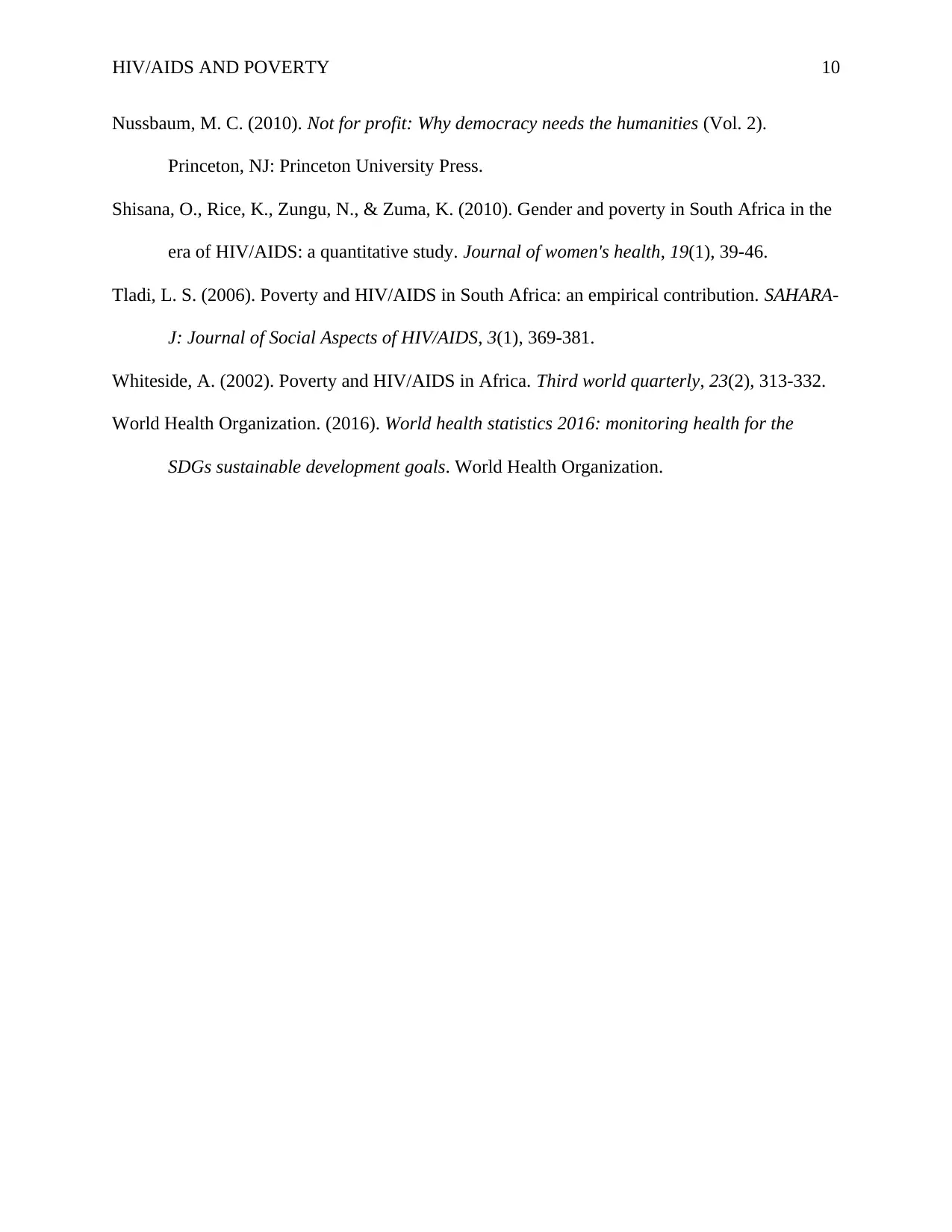
HIV/AIDS AND POVERTY 10
Nussbaum, M. C. (2010). Not for profit: Why democracy needs the humanities (Vol. 2).
Princeton, NJ: Princeton University Press.
Shisana, O., Rice, K., Zungu, N., & Zuma, K. (2010). Gender and poverty in South Africa in the
era of HIV/AIDS: a quantitative study. Journal of women's health, 19(1), 39-46.
Tladi, L. S. (2006). Poverty and HIV/AIDS in South Africa: an empirical contribution. SAHARA-
J: Journal of Social Aspects of HIV/AIDS, 3(1), 369-381.
Whiteside, A. (2002). Poverty and HIV/AIDS in Africa. Third world quarterly, 23(2), 313-332.
World Health Organization. (2016). World health statistics 2016: monitoring health for the
SDGs sustainable development goals. World Health Organization.
Nussbaum, M. C. (2010). Not for profit: Why democracy needs the humanities (Vol. 2).
Princeton, NJ: Princeton University Press.
Shisana, O., Rice, K., Zungu, N., & Zuma, K. (2010). Gender and poverty in South Africa in the
era of HIV/AIDS: a quantitative study. Journal of women's health, 19(1), 39-46.
Tladi, L. S. (2006). Poverty and HIV/AIDS in South Africa: an empirical contribution. SAHARA-
J: Journal of Social Aspects of HIV/AIDS, 3(1), 369-381.
Whiteside, A. (2002). Poverty and HIV/AIDS in Africa. Third world quarterly, 23(2), 313-332.
World Health Organization. (2016). World health statistics 2016: monitoring health for the
SDGs sustainable development goals. World Health Organization.
1 out of 10
Related Documents
Your All-in-One AI-Powered Toolkit for Academic Success.
+13062052269
info@desklib.com
Available 24*7 on WhatsApp / Email
![[object Object]](/_next/static/media/star-bottom.7253800d.svg)
Unlock your academic potential
Copyright © 2020–2025 A2Z Services. All Rights Reserved. Developed and managed by ZUCOL.





